Selenomethionine Ameliorates Cognitive Impairment, Decreases Hippocampal Oxidative Stress and Attenuates Dysbiosis in D-Galactose-Treated Mice
Abstract
:1. Introduction
2. Materials and Methods
2.1. Reagents
2.2. Animals and Experimental Design
2.3. Novel Object Recognition Test
2.4. Passive Avoidance Task
2.5. Morris Water Maze
2.6. Sample Collection
2.7. Measurements of Acetylcholine, Acetyl Cholinesterase, Choline Acetyltransferase, and Monoamine Oxidase
2.8. Determination of Oxidative Stress in the Hippocampus
2.9. Determination of Selenoproteins in the Hippocampus
2.10. Illumina MiSeq Sequencing of 16S rRNA Gene V3-V4 Region of Gut Microbiota
2.11. Statistical Analysis
3. Results and Discussion
3.1. SeMet Improves D-Galactose-Induced Cognitive Impairment
3.2. SeMet Attenuates D-Galactose-Induced Neurotransmitter Dysregulation
3.3. SeMet Modulates Oxidative Stress and Selenoprotein Levels in the Hippocampus
3.4. SeMet Alleviates D-Galactose-Induced Dysbiosis
4. Conclusions
Author Contributions
Funding
Institutional Review Board Statement
Informed Consent Statement
Data Availability Statement
Acknowledgments
Conflicts of Interest
References
- Pyrzynska, K.; Sentkowska, A. Liquid chromatographic analysis of selenium species in plant materials. TrAC Trends Anal. Chem. 2019, 111, 128–138. [Google Scholar] [CrossRef]
- Burk, R.F.; Hill, K.E.; Motley, A.K. Plasma selenium in specific and non-specific forms. Biofactors 2001, 14, 107–114. [Google Scholar] [CrossRef]
- Deagen, J.T.; Butler, J.A.; Beilstein, M.A.; Whanger, P.D. Effects of dietary selenite, selenocystine and selenomethionine on selenocysteine lyase and glutathione peroxidase activities and on selenium levels in rat tissues. J. Nutr. 1987, 117, 91–98. [Google Scholar] [CrossRef]
- Barger, J.L.; Kayo, T.; Pugh, T.D.; Vann, J.A.; Power, R.; Dawson, K.; Weindruch, R.; Prolla, T.A. Gene expression profiling reveals differential effects of sodium selenite, selenomethionine, and yeast-derived selenium in the mouse. Genes Nutr. 2012, 7, 155–165. [Google Scholar] [CrossRef] [Green Version]
- Ananth, S.; Miyauchi, S.; Thangaraju, M.; Jadeja, R.N.; Bartoli, M.; Ganapathy, V.; Martin, P.M. Selenomethionine (se-met) induces the cystine/glutamate exchanger slc7a11 in cultured human retinal pigment epithelial (rpe) cells: Implications for antioxidant therapy in aging retina. Antioxidants 2020, 10, 9. [Google Scholar] [CrossRef]
- Liu, S.J.; Guo, M.Y.; Deng, L.H.; Zhao, G.; Hu, Y.F.; Yi, M.; Wu, S. Protective effect of selenomethionine against ultraviolet b-induced oxidative damage to a human keratinocyte cell line hacat. Chin. J. Dermatol. 2015, 48, 490–493. [Google Scholar]
- Wan, X.L.; Ju, G.Y.; Xu, L.; Yang, H.M.; Wang, Z.Y. Dietary selenomethionine increases antioxidant capacity of geese by improving glutathione and thioredoxin systems. Poult. Sci. 2019, 98, 3763–3769. [Google Scholar] [CrossRef]
- Bai, H.J. Protective Effect of Selenium on Nerve Cell Injury and Preparation of Selenium Enriched Bean Sprouts; Jilin University: Changchun, China, 2020. [Google Scholar]
- Sun, W.Q.; Yin, X.T.; Zhou, Y.R.; Cong, Y.J.; Jiang, X.Y.; Zhao, H.T.; Liu, T.X.; Yu, C.Y.; Zhao, D.F.; Lai, Y.H. Protective effect of selenomethionine on brain tissue of lead-damaged rats and its mechanism. J. Jilin Univ. 2021, 47, 307–314. [Google Scholar]
- Liguori, I.; Russo, G.; Curcio, F.; Bulli, G.; Aran, L.; Della-Morte, D.; Gargiulo, G.; Testa, G.; Cacciatore, F.; Bonaduce, D.; et al. Oxidative stress, aging, and diseases. Clin. Interv. Aging. 2018, 13, 757–772. [Google Scholar] [CrossRef] [Green Version]
- Hajjar, I.; Hayek, S.S.; Goldstein, F.C.; Martin, G.; Jones, D.P.; Quyyumi, A. Oxidative stress predicts cognitive decline with aging in healthy adults: An observational study. J. Neuroinflamm. 2018, 15, 17. [Google Scholar] [CrossRef] [Green Version]
- Yanar, K.; Simsek, B.; Atukeren, P.; Aydin, S.; Cakatay, U. Is d-galactose a useful agent for accelerated aging model of gastrocnemius and soleus muscle of sprague-dawley rats? Rejuvenation Res. 2019, 22, 521–528. [Google Scholar] [CrossRef]
- Azman, K.F.; Zakaria, R. D-galactose-induced accelerated aging model: An overview. Biogerontology 2019, 20, 763–782. [Google Scholar] [CrossRef]
- Zhang, Z.H.; Wu, Q.Y.; Zheng, R.; Chen, C.; Chen, Y.; Liu, Q.; Hoffmann, P.R.; Ni, J.Z.; Song, G.L. Selenomethionine mitigates cognitive decline by targeting both tau hyperphosphorylation and autophagic clearance in an alzheimer’s disease mouse model. J. Neurosci. 2017, 37, 2449–2462. [Google Scholar] [CrossRef]
- Tordoff, M.G.; Bachmanov, A.A.; Reed, D.R. Forty mouse strain survey of water and sodium intake. Physiol. Behav. 2007, 91, 620–631. [Google Scholar] [CrossRef] [Green Version]
- Lueptow, L.M. Novel object recognition test for the investigation of learning and memory in mice. J. Vis. Exp. 2017, 126, e55718. [Google Scholar] [CrossRef]
- Park, C.R.; Seeley, R.J.; Craft, S.; Woods, S.C. Intracerebroventricular insulin enhances memory in a passive-avoidance task. Physiol. Behav. 2000, 68, 509–514. [Google Scholar] [CrossRef]
- Vorhees, C.V.; Williams, M.T. Morris water maze: Procedures for assessing spatial and related forms of learning and memory. Nat. Protoc. 2006, 1, 848–858. [Google Scholar] [CrossRef] [Green Version]
- Gao, Y.; Xu, Y.; Ruan, J.; Yin, J. Selenium affects the activity of black tea in preventing metabolic syndrome in high-fat diet-fed sprague-dawley rats. J. Sci. Food Agric. 2020, 100, 225–234. [Google Scholar] [CrossRef]
- Antunes, M.; Biala, G. The novel object recognition memory: Neurobiology, test procedure, and its modifications. Cogn. Process. 2012, 13, 93–110. [Google Scholar] [CrossRef] [Green Version]
- Zhang, Z.H.; Wu, Q.Y.; Chen, C.; Zheng, R.; Chen, Y.; Ni, J.Z.; Song, G.L. Comparison of the effects of selenomethionine and selenium-enriched yeast in the triple-transgenic mouse model of alzheimer’s disease. Food Funct. 2018, 9, 3965–3973. [Google Scholar] [CrossRef]
- Attaran, A.; Salahinejad, A.; Naderi, M.; Crane, A.L.; Niyogi, S.; Chivers, D.P. Effects of chronic exposure to selenomethionine on social learning outcomes in zebrafish (danio rerio): Serotonergic dysregulation and oxidative stress in the brain. Chemosphere 2020, 247, 125898. [Google Scholar] [CrossRef]
- Attaran, A.; Salahinejad, A.; Naderi, M.; Crane, A.L.; Chivers, D.P.; Niyogi, S. Transgenerational effects of selenomethionine on behaviour, social cognition, and the expression of genes in the serotonergic pathway in zebrafish. Environ. Pollut. 2021, 286, 117289. [Google Scholar] [CrossRef]
- Fernández-Martínez, A.; Charlet, L. Selenium environmental cycling and bioavailability: A structural chemist point of view. Rev. Environ. Sci. Biotechnol. 2009, 8, 81–110. [Google Scholar] [CrossRef]
- Ammar, E.M.; Couri, D. Acute toxicity of sodium selenite and selenomethionine in mice after icv or iv administration. Neurotoxicology 1981, 2, 383–386. [Google Scholar]
- Gao, L.C.; Chen, W.R.; Fu, Z.D.; Ruan, S.Y. Protective effects of selenium on neuron and mitochondria of senile mice. Chin. J. Publ. Health 2002, 18, 769–770. [Google Scholar]
- Perry, E. Acetylcholine and alzheimer’s disease. Br. J. Psychiatry 1988, 152, 737–740. [Google Scholar] [CrossRef]
- Lopez, C.M.; Govoni, S.; Battaini, F.; Bergamaschi, S.; Longoni, A.; Giaroni, C.; Trabucchi, M. Effect of a new cognition enhancer, alpha-glycerylphosphorylcholine, on scopolamine-induced amnesia and brain acetylcholine. Pharmacol. Biochem. Behav. 1991, 39, 835–840. [Google Scholar] [CrossRef]
- Ferreira-Vieira, T.H.; Guimaraes, I.M.; Silva, F.R.; Ribeiro, F.M. Alzheimer’s disease: Targeting the cholinergic system. Curr. Neuropharmacol. 2016, 14, 101–115. [Google Scholar] [CrossRef] [Green Version]
- Haam, J.; Yakel, J.L. Cholinergic modulation of the hippocampal region and memory function. J. Neurochem. 2017, 142, 111–121. [Google Scholar] [CrossRef] [Green Version]
- Sparks, D.L.; Woeltz, V.M.; Markesbery, W.R. Alterations in brain monoamine oxidase activity in aging, alzheimer’s disease, and pick’s disease. Arch. Neurol. 1991, 48, 718–721. [Google Scholar] [CrossRef]
- Rahman, M.S.; Uddin, M.S.; Rahman, M.A.; Samsuzzaman, M.; Behl, T.; Hafeez, A.; Perveen, A.; Barreto, G.E.; Ashraf, G.M. Exploring the role of monoamine oxidase activity in aging and alzheimer’s disease. Curr. Pharm. Des. 2021, 27, 4017–4029. [Google Scholar] [CrossRef]
- Hanagasi, H.A.; Gurvit, H.; Unsalan, P.; Horozoglu, H.; Tuncer, N.; Feyzioglu, A.; Gunal, D.I.; Yener, G.G.; Cakmur, R.; Sahin, H.A.; et al. The effects of rasagiline on cognitive deficits in parkinson’s disease patients without dementia: A randomized, double-blind, placebo-controlled, multicenter study. Mov. Disord. 2011, 26, 1851–1858. [Google Scholar] [CrossRef]
- Matthews, D.C.; Ritter, A.; Thomas, R.G.; Andrews, R.D.; Lukic, A.S.; Revta, C.; Kinney, J.W.; Tousi, B.; Leverenz, J.B.; Fillit, H.; et al. Rasagiline effects on glucose metabolism, cognition, and tau in alzheimer’s dementia. Alzheimers Dement 2021, 7, e12106. [Google Scholar] [CrossRef]
- Liu, Y.L.; Li, X.E. Effect of protein and anthraquinone glycosides from radix polygoni multiflori on learning and memory and metabolites in d-galactose-induced aging mice. J. Guangzhou Univ. Tradit. Chin. Med. 2009, 26, 160–163. [Google Scholar]
- Jiang, T.; Huang, B.K.; Zhang, Q.Y.; Han, T.; Zheng, H.C.; Qin, L.P. Effect of liriope platyphylla total saponin on learning, memory and metabolites in aging mice induced by d-galactose. J. Chin. Integr. Med. 2007, 5, 670–674. [Google Scholar] [CrossRef]
- Ahmed, T.; Braidy, N. Editorial: From oxidative stress to cognitive decline-towards novel therapeutic approaches. Front. Mol. Neurosci. 2021, 14, 650498. [Google Scholar] [CrossRef]
- Glade, M.J. Oxidative stress and cognitive longevity. Nutrition 2010, 26, 595–603. [Google Scholar] [CrossRef]
- Girgin Sagin, F.; Sozmen, E.Y.; Ersoz, B.; Mentes, G. Link between monoamine oxidase and nitric oxide. Neurotoxicology 2004, 25, 91–99. [Google Scholar] [CrossRef]
- Ohashi, M.; Hirano, T.; Watanabe, K.; Katsumi, K.; Ohashi, N.; Baba, H.; Endo, N.; Kohno, T. Hydrogen peroxide modulates synaptic transmission in ventral horn neurons of the rat spinal cord. J. Physiol. 2016, 594, 115–134. [Google Scholar] [CrossRef] [Green Version]
- Cheeseman, K.H.; Slater, T.F. An introduction to free radical biochemistry. Br. Med. Bull. 1993, 49, 481–493. [Google Scholar] [CrossRef]
- Yamagishi, S.; Maeda, S.; Matsui, T.; Ueda, S.; Fukami, K.; Okuda, S. Role of advanced glycation end products (ages) and oxidative stress in vascular complications in diabetes. Biochim. Biophys. Acta 2012, 1820, 663–671. [Google Scholar] [CrossRef]
- Akhter, F.; Chen, D.; Akhter, A.; Sosunov, A.A.; Chen, A.; McKhann, G.M.; Yan, S.F.; Yan, S.S. High dietary advanced glycation end products impair mitochondrial and cognitive function. J. Alzheimers Dis. 2020, 76, 165–178. [Google Scholar] [CrossRef]
- Wang, T.; Fu, F.; Han, B.; Zhang, L.; Zhang, X. Danshensu ameliorates the cognitive decline in streptozotocin-induced diabetic mice by attenuating advanced glycation end product-mediated neuroinflammation. J. Neuroimmunol. 2012, 245, 79–86. [Google Scholar] [CrossRef]
- Rungratanawanich, W.; Qu, Y.; Wang, X.; Essa, M.M.; Song, B.J. Advanced glycation end products (ages) and other adducts in aging-related diseases and alcohol-mediated tissue injury. Exp. Mol. Med. 2021, 53, 168–188. [Google Scholar] [CrossRef]
- West, R.K.; Moshier, E.; Lubitz, I.; Schmeidler, J.; Godbold, J.; Cai, W.; Uribarri, J.; Vlassara, H.; Silverman, J.M.; Beeri, M.S. Dietary advanced glycation end products are associated with decline in memory in young elderly. Mech. Ageing. Dev. 2014, 140, 10–12. [Google Scholar] [CrossRef] [Green Version]
- Kumar, B.S.; Kunwar, A.; Singh, B.G.; Ahmad, A.; Priyadarsini, K.I. Anti-hemolytic and peroxyl radical scavenging activity of organoselenium compounds: An in vitro study. Biol. Trace Elem. Res. 2011, 140, 127–138. [Google Scholar] [CrossRef]
- Bao, J.H.; Su, C.; Xu, H.B. A study on scavenging effect of selenium compounds upon hydroxyl radical with spin trapping. J. Inorg. Chem. 1992, 8, 107–109. [Google Scholar]
- Bai, Y.; Qin, B.Y.; Liu, Y.; Hong, W.; Zhou, Y.F. Study on superoxide anion radical scavenging activity of seleno-sulfur-containing amino acid. Acta Nutr. Sin. 2009, 31, 26–29. [Google Scholar]
- Zhang, J.; Piantadosi, C.A. Prevention of h2o2 generation by monoamine oxidase protects against cns o2 toxicity. J. Appl. Physiol. 1991, 71, 1057–1061. [Google Scholar] [CrossRef]
- Scharpf, M.; Schweizer, U.; Arzberger, T.; Roggendorf, W.; Schomburg, L.; Kohrle, J. Neuronal and ependymal expression of selenoprotein p in the human brain. J. Neural Transm. 2007, 114, 877–884. [Google Scholar] [CrossRef]
- Bellinger, F.P.; Raman, A.V.; Reeves, M.A.; Berry, M.J. Regulation and function of selenoproteins in human disease. Biochem. J. 2009, 422, 11–22. [Google Scholar] [CrossRef] [Green Version]
- Zhang, Y.; Roh, Y.J.; Han, S.J.; Park, I.; Lee, H.M.; Ok, Y.S.; Lee, B.C.; Lee, S.R. Role of selenoproteins in redox regulation of signaling and the antioxidant system: A review. Antioxidants 2020, 9, 383. [Google Scholar] [CrossRef]
- Gao, W.; Baumgartel, K.L.; Alexander, S.A. The gut microbiome as a component of the gut-brain axis in cognitive health. Biol. Res. Nurs. 2020, 22, 485–494. [Google Scholar] [CrossRef]
- Luca, M.; Chattipakorn, S.C.; Sriwichaiin, S.; Luca, A. Cognitive-behavioural correlates of dysbiosis: A review. Int. J. Mol. Sci. 2020, 21, 4834. [Google Scholar] [CrossRef]
- Tooley, K.L. Effects of the human gut microbiota on cognitive performance, brain structure and function: A narrative review. Nutrients 2020, 12, 3009. [Google Scholar] [CrossRef]
- Zhou, D.C.; Wang, M.; Jiang, H. Correlation between intestinal microecological changes and cognitive function in elderly patients with alzheimer’s disease. Chin. J. Microecol. 2020, 32, 700–704. [Google Scholar]
- Kwak, Y.K.; Vikstrom, E.; Magnusson, K.E.; Vecsey-Semjen, B.; Colque-Navarro, P.; Mollby, R. The staphylococcus aureus alpha-toxin perturbs the barrier function in caco-2 epithelial cell monolayers by altering junctional integrity. Infect. Immun. 2012, 80, 1670–1680. [Google Scholar] [CrossRef] [Green Version]
- Xu, Y.C. Dietary Methionine Restriction Improves the Learning and Memory Function of Obese Mice and Aging Mice; Jiangnan University: Wuxi, China, 2019. [Google Scholar]
- Wang, X.; Sun, G.; Feng, T.; Zhang, J.; Huang, X.; Wang, T.; Xie, Z.; Chu, X.; Yang, J.; Wang, H.; et al. Sodium oligomannate therapeutically remodels gut microbiota and suppresses gut bacterial amino acids-shaped neuroinflammation to inhibit alzheimer’s disease progression. Cell Res. 2019, 29, 787–803. [Google Scholar] [CrossRef]
- Chen, T.; Jia, J.; Ye, F.; Qin, B.Y.; Wang, Q.; Yang, J.Y.; Huang, Y.Z.; Zhou, S.H. Effect of exogenous hydrogen sulfide on spatial learning memory deficit and the hippocampal structure in model of alzheimer’s disease rats. Chin. J. Neuroanat. 2012, 28, 75–78. [Google Scholar]
- Jia, Q.; Li, Y.; Liu, X.F.; Wang, Y.Y.; Yang, R.; Ma, S.F. Effects of hydrogen sulfide on spatial learning and memory and oxidative stress in hippocampus tissue of diabetic rat. J. Bengbu Med. Coll. 2020, 45, 447–451. [Google Scholar]
- Ou, Z.; Deng, L.; Lu, Z.; Wu, F.; Liu, W.; Huang, D.; Peng, Y. Protective effects of akkermansia muciniphila on cognitive deficits and amyloid pathology in a mouse model of alzheimer’s disease. Nutr. Diabetes 2020, 10, 12. [Google Scholar] [CrossRef] [Green Version]
- Higarza, S.G.; Arboleya, S.; Arias, J.L.; Gueimonde, M.; Arias, N. Akkermansia muciniphila and environmental enrichment reverse cognitive impairment associated with high-fat high-cholesterol consumption in rats. Gut Microbes 2021, 13, 1–20. [Google Scholar] [CrossRef]
- Kasaikina, M.V.; Kravtsova, M.A.; Lee, B.C.; Seravalli, J.; Peterson, D.A.; Walter, J.; Legge, R.; Benson, A.K.; Hatfield, D.L.; Gladyshev, V.N. Dietary selenium affects host selenoproteome expression by influencing the gut microbiota. FASEB J. 2011, 25, 2492–2499. [Google Scholar] [CrossRef] [Green Version]
- Zhai, Q.; Xiao, Y.; Li, P.; Tian, F.; Zhao, J.; Zhang, H.; Chen, W. Varied doses and chemical forms of selenium supplementation differentially affect mouse intestinal physiology. Food Funct. 2019, 10, 5398–5412. [Google Scholar] [CrossRef]
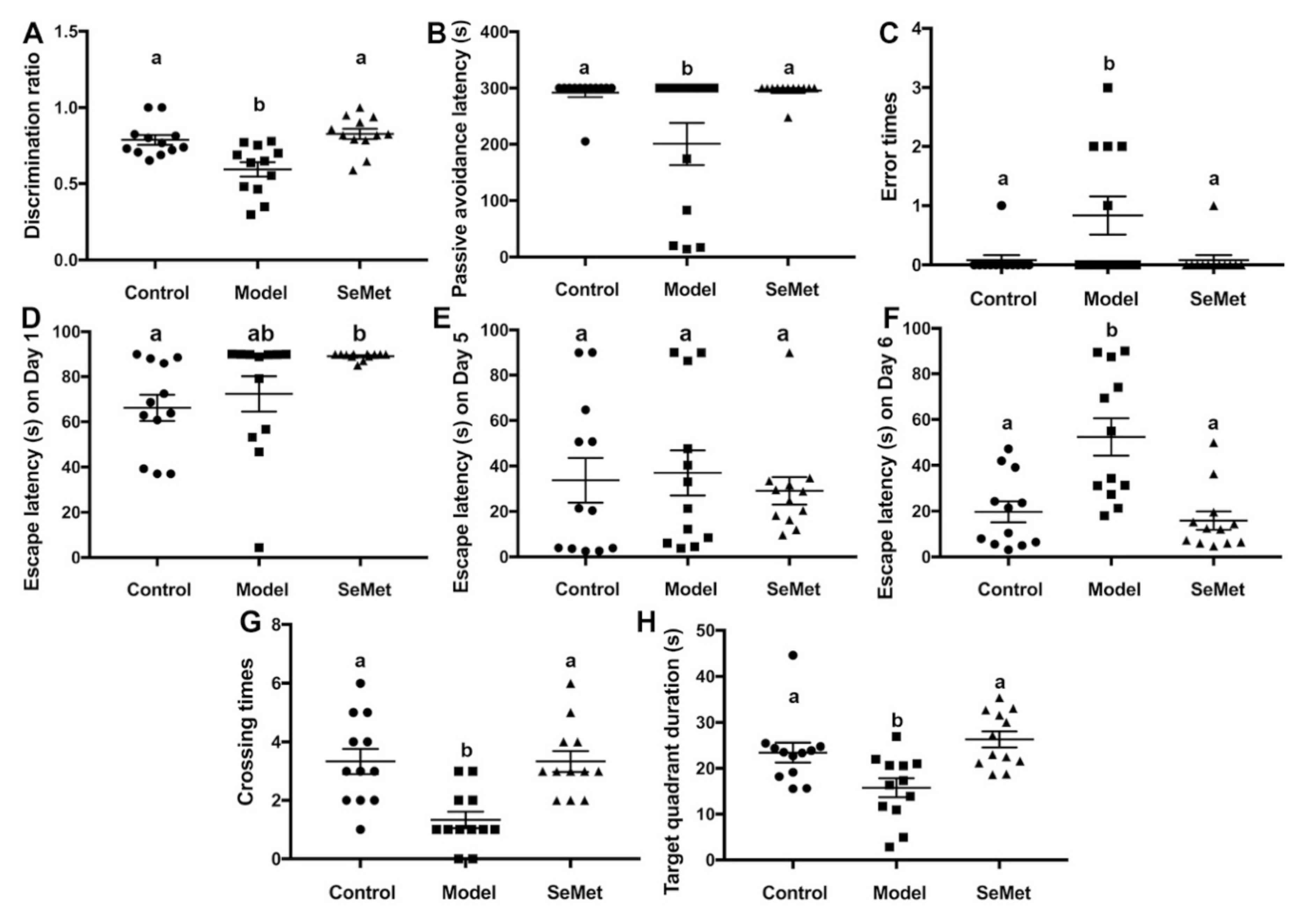
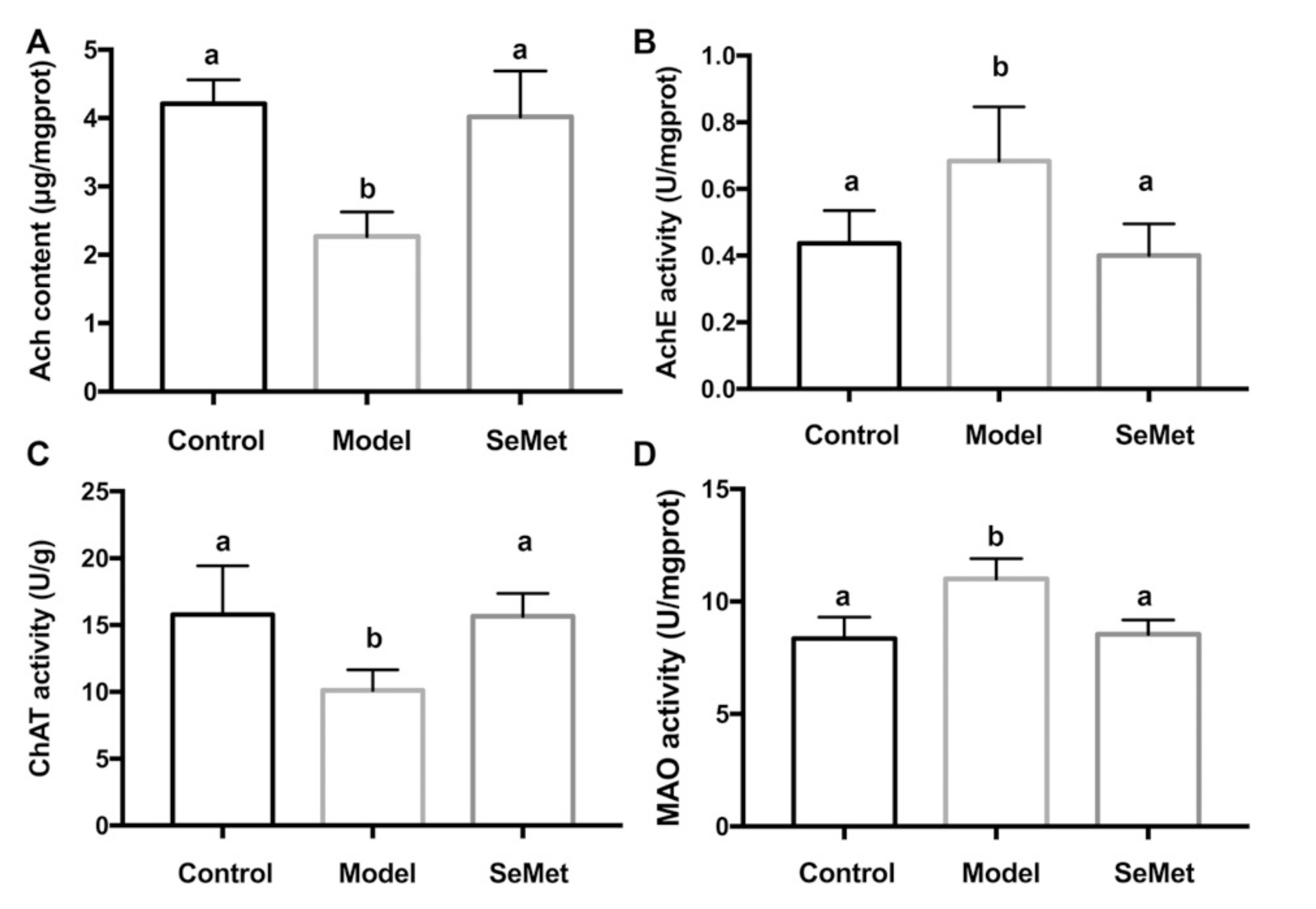
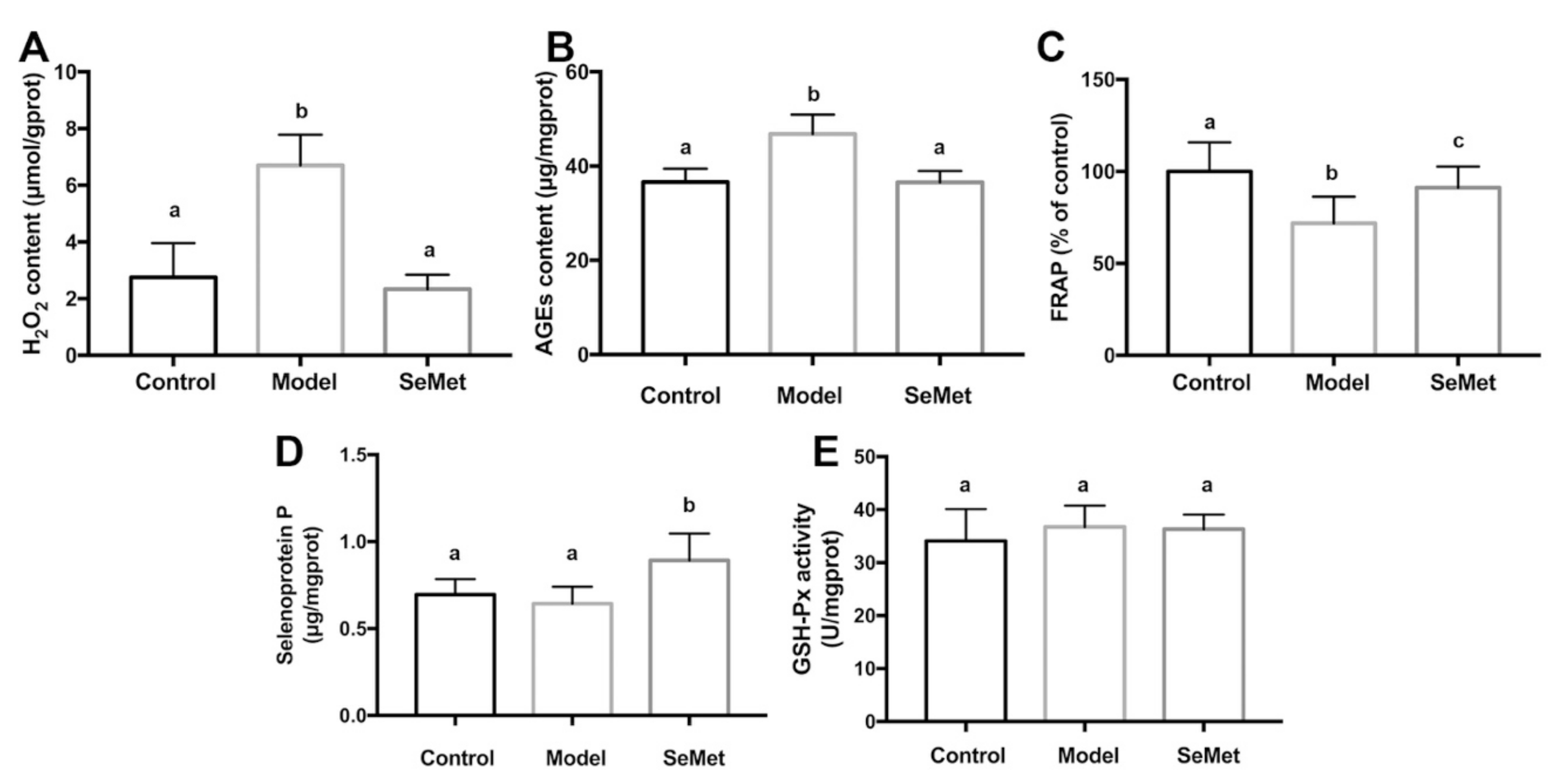

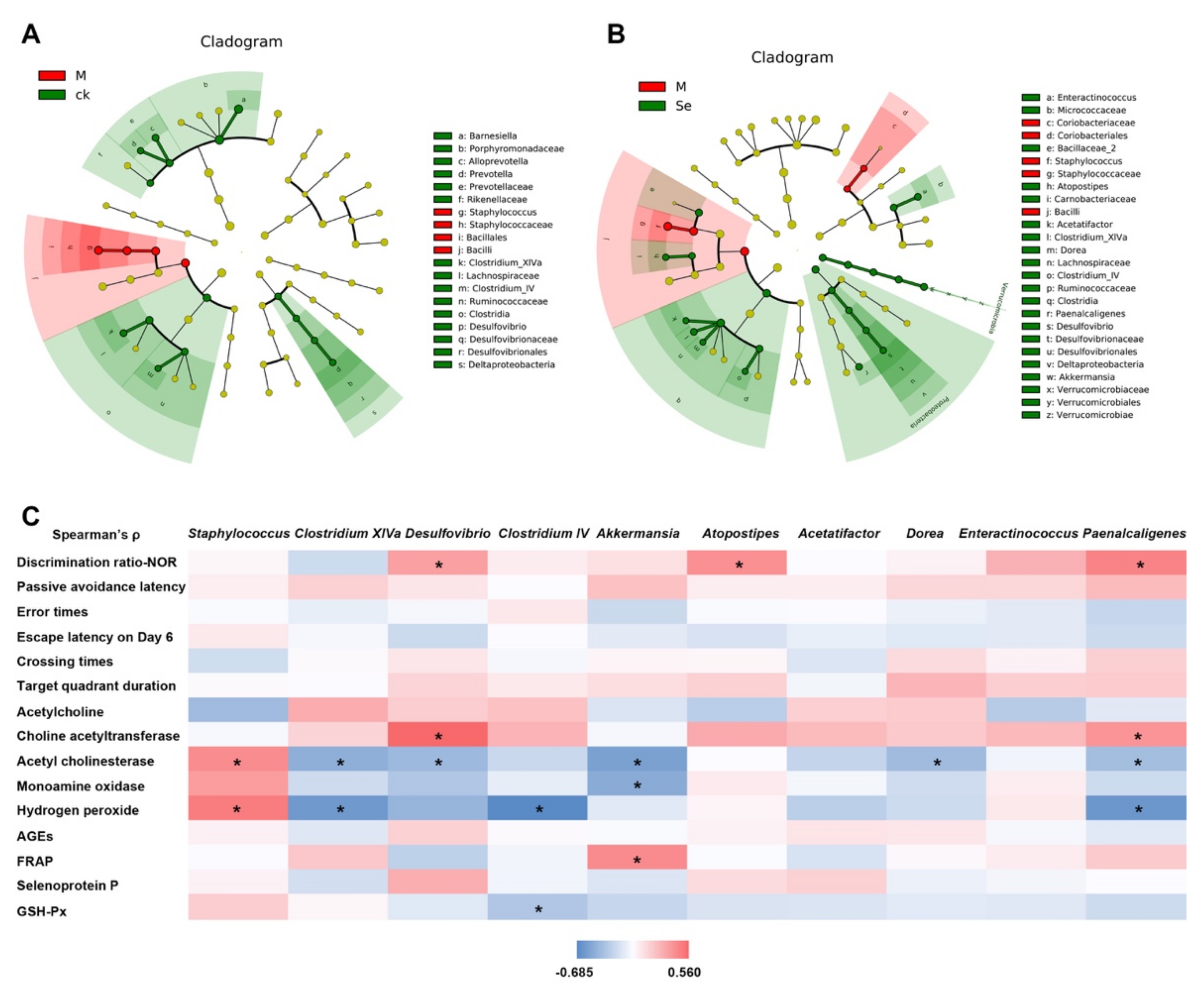
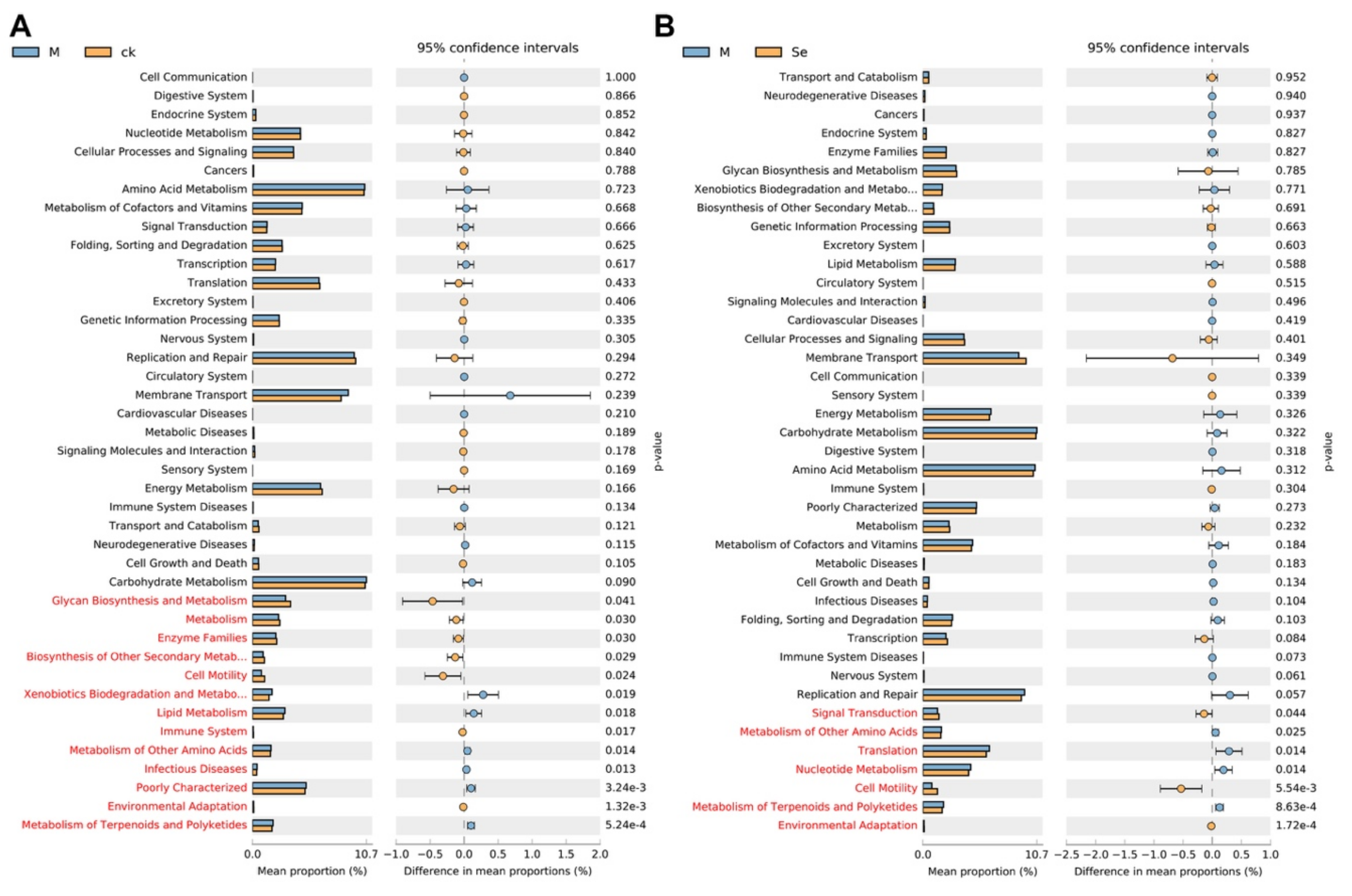
Publisher’s Note: MDPI stays neutral with regard to jurisdictional claims in published maps and institutional affiliations. |
© 2022 by the authors. Licensee MDPI, Basel, Switzerland. This article is an open access article distributed under the terms and conditions of the Creative Commons Attribution (CC BY) license (https://creativecommons.org/licenses/by/4.0/).
Share and Cite
Gao, Y.; Xu, Y.; Yin, J. Selenomethionine Ameliorates Cognitive Impairment, Decreases Hippocampal Oxidative Stress and Attenuates Dysbiosis in D-Galactose-Treated Mice. Antioxidants 2022, 11, 111. https://doi.org/10.3390/antiox11010111
Gao Y, Xu Y, Yin J. Selenomethionine Ameliorates Cognitive Impairment, Decreases Hippocampal Oxidative Stress and Attenuates Dysbiosis in D-Galactose-Treated Mice. Antioxidants. 2022; 11(1):111. https://doi.org/10.3390/antiox11010111
Chicago/Turabian StyleGao, Ying, Yongquan Xu, and Junfeng Yin. 2022. "Selenomethionine Ameliorates Cognitive Impairment, Decreases Hippocampal Oxidative Stress and Attenuates Dysbiosis in D-Galactose-Treated Mice" Antioxidants 11, no. 1: 111. https://doi.org/10.3390/antiox11010111
APA StyleGao, Y., Xu, Y., & Yin, J. (2022). Selenomethionine Ameliorates Cognitive Impairment, Decreases Hippocampal Oxidative Stress and Attenuates Dysbiosis in D-Galactose-Treated Mice. Antioxidants, 11(1), 111. https://doi.org/10.3390/antiox11010111







